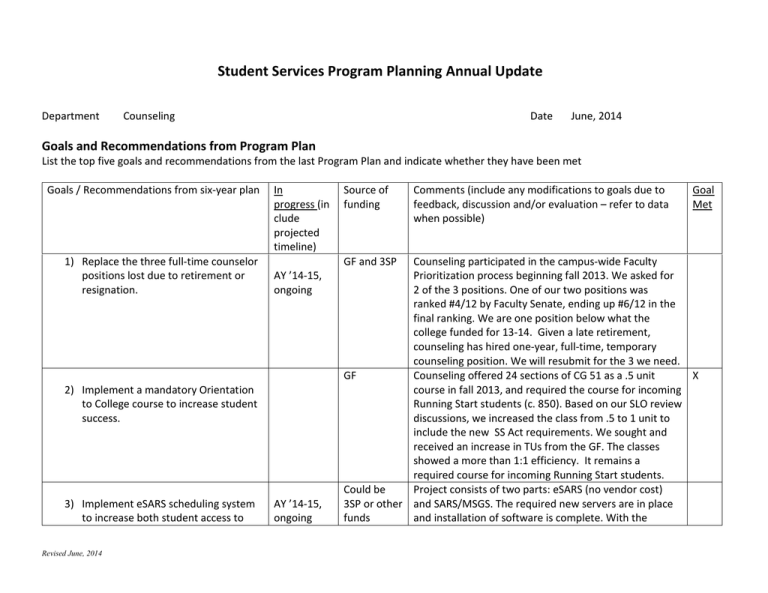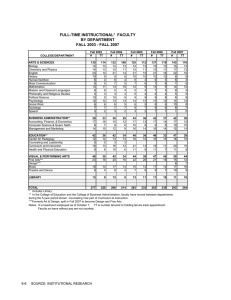Student Services Program Planning Annual Update
advertisement

Student Services Program Planning Annual Update Department Counseling Date June, 2014 Goals and Recommendations from Program Plan List the top five goals and recommendations from the last Program Plan and indicate whether they have been met Goals / Recommendations from six-year plan 1) Replace the three full-time counselor positions lost due to retirement or resignation. In progress (in clude projected timeline) AY ’14-15, ongoing 2) Implement a mandatory Orientation to College course to increase student success. 3) Implement eSARS scheduling system to increase both student access to Revised June, 2014 AY ’14-15, ongoing Source of funding GF and 3SP Comments (include any modifications to goals due to feedback, discussion and/or evaluation – refer to data when possible) Goal Met Counseling participated in the campus-wide Faculty Prioritization process beginning fall 2013. We asked for 2 of the 3 positions. One of our two positions was ranked #4/12 by Faculty Senate, ending up #6/12 in the final ranking. We are one position below what the college funded for 13-14. Given a late retirement, counseling has hired one-year, full-time, temporary counseling position. We will resubmit for the 3 we need. GF Counseling offered 24 sections of CG 51 as a .5 unit X course in fall 2013, and required the course for incoming Running Start students (c. 850). Based on our SLO review discussions, we increased the class from .5 to 1 unit to include the new SS Act requirements. We sought and received an increase in TUs from the GF. The classes showed a more than 1:1 efficiency. It remains a required course for incoming Running Start students. Could be Project consists of two parts: eSARS (no vendor cost) 3SP or other and SARS/MSGS. The required new servers are in place funds and installation of software is complete. With the counseling appointments and to increase technological aspects to services. (low touch) 4) Organize Counseling and Transfer/Career Center’s physical space in the 100 building to create one entrance with improved signage and screening systems. 5) Provide additional computers for the Career/Transfer Center laboratory area and obtain internet access for PC behind the CC/TC desk that projects Power Point Revised June, 2014 AY ’14-15, ongoing Summer ’14 completion 3SP and District funds Transfer Center Funds, Faculty grants for infrastructu re; 3SP implementation of Ed Plan and Probation/Dismissal workshops, Student Planning, Registration Priority changes, and changes to how we deal with Academic Standing, the division is seeing more than ever, the need for thorough and detailed screening of students prior to scheduling an appointment. The division is concerned that moving to eSARS at this time will undermine the progress made in properly screening students in our current forms. Therefore, we are postponing implementation of eSARS at this time until it can be done thoughtfully and correctly. We are working with IT to see about our options for implementing SARS/MSGS in the absence of eSARS. In late fall 2013, the counseling reception area moved to the Transfer Center side of the building, realizing a decade long goal. This allows for a better screening and student flow process. Staff meetings were held to develop an approach for improved student flow and signage. This was interrupted by a one-semester (Sp ‘14) move to the 200 building. Currently, new signage is being installed, and our efforts to integrate the best flow possible for students will continue. Infrastructure is being developed as a part of the 100 building upgrades. 10 VDIs have been purchased with 3SP funds New Goals and Recommendations Since Last Program Plan List any new goals and recommendations identified by the department Goal/Recommendation (include timeline) Cost Increase FT Counseling faculty by 3 additional counselors in order to implement requirements of the Student Success Act of 2012. These are new positions over and above replacement positions. $278,336 Restore the Transfer/Career Center Coordinator position to a Director position with a 195-day contract Approx. $5000 General Fund Continue with implementation of requirements of the Student Success Act of 2012 (SB 1456) (potential source of revenue from state budget) Revised June, 2014 Explanation/Evidence of Need (indicate how this need was assessed) The SSA requires that all new students have a comprehensive Education Plan after 15 degreeapplicable units or 3rd semester. We are unable to meet this requirement with current staffing. To align Cabrillo’s Transfer Center leadership position with comparable positions around the state. Recommended by Region 4 CCC Transfer Center Director’s Assoc. The new Student Success and Support program formula relies heavily on the provision of counseling services, including the Abbreviated and Comprehensive Education Plans and follow-up services Status (Comment on progress of new goals/recommendations listed in last annual update) Counselor/Student ratio is approximately 1:1100, with full implementation of SSA requirements needed within the coming year. The position is currently supplemented with 4 additional Academic Specialist units in order to accomplish the work needed. The change was made a number of years ago for reasons that are not appropriate to the role. Mandatory CG 51 Intro to College course (now 1 unit) required for incoming first year Running Start students; Required workshop for student on Probation level 2; Dismissed students now actually required to sit out for one semester; Ed Plan Workshops designed to help students develop Abbreviated Ed Plan; implementation of Student Planning Sp ’14; collaboration with Financial Aid being worked on to Increase Student Services Assistant (SSA) from 10 month to 11 month Add a part-time 60% SSA position to support the increase in required education plan workshops Continue with Progress/ Dismissal Workshops Continue with Ed Plan Workshops Revised June, 2014 $ c. 6700 Restore from SPRAC reductions; c. $22K SSP budget Additional SSA position needed to provide the Ed Plan workshops and Student Planning sessions, a key piece to developing the electronic education plan Follow-up Services to at-risk students required by SB 1456 Increased Education Plan requirements of SB 1456. streamline messaging to all students regarding when the workshop is appropriate; updated webpage to better inform students of Ed Plan requirements and instructions for using the Student Planning tool; implementing Student Planning Sessions (Su ’14) SSAs are the primary providers of workshops and are also adding 1-1 and group Student Planning sessions With 20 students, 3 presenters are needed for the last one hour of the workshop to help students get on Student Planning. Same as above Workshops held weekly at Aptos and Watsonville. Students complete change contract which is scanned to the student’s file; original mailed back. Attending workshop clears the immediate hold. Attending the workshop and then meeting the cumulative academic expectations in each individual semester will result in any future holds being removed. Workshops are held weekly at Aptos and Watsonville. Recent Review and revise our SARS appointment Reason Codes to better align with new MIS reporting elements being developed as a result of the Student Success Act of 2012. We currently manually enter contact information (by Reason Code reports from SARS) into Datatel to inform the MIS reporting needs. change in messaging to student on the counseling webpage to better direct the right students to the workshop. All areas on campus that provide counseling now use SARS, allowing for a more accurate accounting of Reason Codes. CESS has done initial correlation of SARS codes to new MIS codes; waiting for IT to implement the requirement. Timeline is critical for IT to implement (Su ‘14) SSLO/AUO Assessment Progress In a sentence or two, describe where your department should be with ongoing assessment (what assessment you should have done in the last year) and what was actually done. If any task was not completed, explain why. We are on track with our “wheel of assessment”. In fall 2013, each CG course was assessed for the Core 4 Critical Thinking. In Spring 2014, each CG course was assessed for the Core 4 Communication. Fill out the Assessment Results section below. SSLO/AUO Assessment Results List SSLO/AUO assessments, dialogues, and priorities identified as a result of your assessment below. Attach Departmental Assessment Analysis Forms completed in the last two semesters. Revised June, 2014 Core Competency, Program SSLO/AUO Assessed Counseling program-level SLO assessed in spring 2013 CG Course SLOS assessed in Spring 2013: CG 1, 51, 52, 54, 107, 205 Date of meeting where analysis / dialogue took place. Example: Department Meeting on 00/00/2012 Counseling meeting on 8/22/13 Priorities identified for program as a result of assessment. Student surveys revealed that when the Ed goal is clearer, the student better understands the next math course needed. Priority #1 was to work with assessment on how the scores are displayed to the student on the assessment print out; needs to be simpler. Director met with assessment staff to make changes within the parameters allowed by the programming driving the report. Some modifications were made. Counseling meeting on 8/22/13 Priority #2 was to work with the math department to clear up misconceptions held by our students; are we on the same page in terms of how we advise students. Director met in two meetings with the math department to discuss the flow of courses, particularly in light of Math 142; and to discuss the title of Math 142 and what it implies to students. Wheel of Assessment clarified. Expectations for fall ’13 assessment clarified. All those who teach the same class need to collaborate more on content and meeting the same SLO. Meetings specific to CG 54 and CG 51 were held in the AY ’13-14 to address this need. Such meetings will continue. A general plan was identified to offer additional sections of CG 54 (career planning) in spring semesters to move undecided students (at 15 units) towards the new required Career Goal/Ed Goal, Program of Study/Major. Other ways to assist students with career assessment is in the planning for AY ‘14-15. The max enrollment in CG courses increased from 30-33. Revised June, 2014 CG Course SLOs assessed in fall 2013: CG 1, 51, 52, 54, 205 Revised June, 2014 Counseling meeting on 2/7/14 Priorities identified: • Increase class units from .5 to 1 in CG 51 (complete). • Continue to require CG 51 for incoming Running Start students. • Encourage collaboration between instructors of CG 51. A Sp ‘14 meeting was held and a fall ’14, 3-hour flex activity is scheduled to increase collaboration between instructors. • Have more faculty attend FELI, other conferences such as On Course, and trainings in career assessment instruments.
